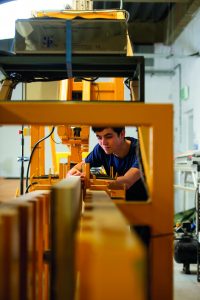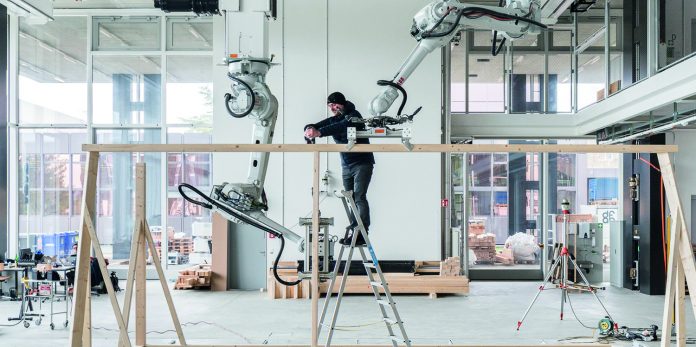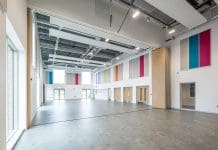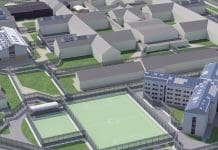Professor Robert Hairstans, head of the Centre for Offsite Construction & Innovative Structures at Edinburgh Napier University, assesses how further education must adapt to the needs of the industry amid a pandemic
The economic ramifications of Covid-19 are yet to be fully realised but they are certainly going to be felt for years, if not decades, to come. Despite the many detrimental impacts of the pandemic, it is now time to recognise the positive effects of flexible working and improved levels of productivity using digital technology.
But what does this mean for traditional construction? A sector where productivity has stagnated and yet still consumes approximately half of all extracted materials, while contributing an estimated 39% of all emissions. A sector that needs to respond by 2050 to a global population increase of 27% to 9.8bn necessitating a doubling of building stock that will ultimately catapult all of the environmental, social and economic impacts associated with the built environment. There isn’t a vaccine for the climate crisis but the current circumstances provide an opportunity to reset the dial in terms of our long-term impact on the planet.
There is a necessity to move towards progressive delivery approaches harnessing the trifecta of timber, digitisation and factory underpinned by the next generation of built environment professionals. This approach needs to embrace circularity and deliver not only new building systems using regenerative design principles but determine ways of enhancing the existing building stock to ensure overall resilience.
Reducing carbon emissions
Biogenic offsite manufacture (bio-OSM), which uses naturally renewable resources converted in a factory for construction, can produce energy (fabric-first approach) and material-efficient buildings through:
- Enhanced levels of productivity.
- Minimal waste.
- Carbon sequestration.
A 10,000m3 per annum cross-laminated timber plant, for example, would sequestrate 6,760,000kg of carbon dioxide (CO2) from the atmosphere assuming -676kg of CO2 per m3 will be stored after the production process. A recent study also estimates 50Mt greenhouse gases (CO2e) in upfront avoided emissions, without considering any carbon sequestration and storage potential offered, would result from substituting concrete floor slabs with timber in steel building frames for the next 30 years.
Learning to collaborate
The next generation of built environment professionals will require a different approach to education – a new model to ensure bio-OSM is implemented. No longer can the professions work in silos; collaboration is fundamental given the necessity to demonstrate the whole lifecycle value proposition of bio-OSM approaches rather than traditional lowest cost/lowest quality forms of delivery driven by antiquated procurement and business model approaches. Theories of circularity must be embedded in the mindset to ensure maximum value is driven from available resources and for this value to be retained as long as possible before returning CO2 to the atmosphere.
Through economic uncertainties, construction site restrictions, workplace social distancing and remote working, the Covid-19 pandemic has accelerated the need to find safer and smarter ways of building with OSM powered by digital technology capable of creating sustainable, fast and high-quality housing. There is a necessity to provide further evidence to this which Industry 4.0 and digitisation presents. A digital twin of the built asset with a feedback loop to Building Performance Evaluation (BPE) and Post Occupancy Evaluation (POE) information can validate the predicted performance and correspondingly improve business model and procurement practices to consider whole-life performance rather than the traditional lowest cost, lowest quality approach.
The next generation of professionals should have flexible career paths as they underpin the progress necessary to mainstream these approaches and the delivery of a built environment that has a positive influence on the health and wellbeing of its occupants. These new built environments should be capable of embracing the personalisation offered by Industry 5.0 through the collaboration of human skills and digitisation. Workers in Industry 5.0 will be upskilled to provide value-added tasks in production, leading to mass customisation and personalisation for customers. Research work into these types of approaches has been pioneered at ETH Zurich. Factory shift patterns can better manage social distancing, automation can reduce manual handling and personalisation can ensure continuous added value.
Adapting to change
To embrace what will hopefully be a new sustainable normal the current educational model needs to evolve from the existing medium of lectures supplemented by exercise classes or tutorials and laboratory experiments. There needs to be a platform for idea and talent creation that drives innovation and knowledge by triangulating academic expertise, industry mentorship and student talent. This could include:
- Interactive and flipped classes.
- Recorded lectures.
- Online material, games and simulations.
- Working in a group or team (sometimes involving students from more than one year or more than one continent).
- Design-build-test projects.
- Competitive team activities.
- Problem-based learning.
- Interdisciplinary and multidisciplinary projects.
- Capstone projects (often in collaboration with industry).
- Dragons’ Den-style presentations.
- Constructive failure.
- Raising sponsorship.
- Leadership training.
- Outreach work with children in schools etc.
The lecturers’ role would therefore change to one of academic supervision and industrial mentorship, resulting in an enhanced student experience.

Mapping talent
Delivering the built environment is exciting and students should experience this. For example, student talent can be mapped on to live industry projects providing technical support and innovation intervention on a rolling basis via a standardised workflow as demonstrated by the award-winning Edinburgh Napier University – Built Environment Exchange initiative.
For baseline knowledge, students should be upskilled in accordance with a defined competency framework while having flexibility to create their own pathway. The CITB-funded Offsite Ready collaborative project led by the Construction Scotland Innovation Centre exemplifies this. Knowledge ascertained should be applied to, for example:
- Benchmarking a range of good practice and exemplar case studies for systematic review.
- Digitisation and parametric interrogation to provide an evidence base for performance claims made by the sector.
- Identifying knowledge gaps and areas of future research focus.
Conclusion and next steps
Industry demands the ability to demonstrate the whole-life value proposition of using timber technology and offsite manufacturing approaches to the wider community. Student learning can be centred on this so that the educational programme creates return to the sector by implementing an approach that codifies information and demonstrates value.
The following key actions should be taken:
- Create a cluster of UK-wide academic expertise that can work with industry and stakeholders to address future industry challenges through the curriculum.
- Implement strategic partnerships with identified collaborating organisations creating access to available facilities, research and industry innovation UK wide.
- Outline a thematic roadmap of research areas with industry and external stakeholders for student engagement.
- Create a competency framework and a series of upskilling pathways for students to follow and have flexibility within.
- Create a core curriculum using experiential learning techniques capable of being accredited by a professional body such as the Institution of Engineering & Technology.
- Set-up curriculum activities to address industry challenges via student / industry engagement including the implementation of a flexible industry apprenticeship model.
This is an extract from TRADA’s Timber Industry Yearbook. For full supporting references and further reading, please visit TRADA.co.uk.
Professor Robert Hairstans
Head of the Centre for Offsite Construction & Innovative Structures
Edinburgh Napier University
Tel: +44 (0)1494 569603
Twitter: @TRADA_
LinkedIn: Trada

















